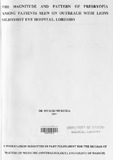| dc.contributor.author | Mukuria, Mukuria | |
| dc.date.accessioned | 2014-01-24T16:19:31Z | |
| dc.date.available | 2014-01-24T16:19:31Z | |
| dc.date.issued | 2009 | |
| dc.identifier.citation | Masters Of Medicine (ophthalmology), University Of Namobi, 2009 | en_US |
| dc.identifier.uri | http://hdl.handle.net/11295/64319 | |
| dc.description.abstract | Objective: To determine the magnitude and pattern of presbyopia among patients aged
35 years and above as seen on outreach with Lions Sightfirst Eye Hospital.
Method: Cross sectional outreach camp based study of presbyopia at various centres
visited by Lions sightfirst eye hospital was carried out on patients 35 years old above.
Those with prior intraocular surgery, unclear ocular media or BCY A for distance ofless
than 6/60 were excluded. The BCY A for distance was determined after refracting using
appropriate plus or minus lenses and illiterate E distance chart at 6m before assessing
presence and severity of presbyopia with an illiterate E near chart and plus lenses. Data
was collected using a questionnaire and input and analysed using SPSS version 11.5 and
Epi info version 3.4.1.
A case was a patient aged 35 years and above found to improve by at least I line on the
near chart with addition with plus lenses.
Results: A total of 442 patients were examined of which 177 (40%) were male and 265
(60%) female. Males were found to be older than females p<O.OOl. Refractive errors
were found in 16.1% of those examined. Presbyopia was found in 388(87.8%) of those
examined, males= 151(85.3%) and females= 237(89.4%). 0 significant difference in
frequency of presbyopia by sex p=0.195 but males required a higher presbyopia
correction p=O.OOl. Females had significant earlier presentation of presbyopia p=0.008.
Those with less education were found to have more severe presbyopia by age p=0.004.
Overall presbyopia was found to start at an earlier age and have a more gradual incline in
severity then plateau at a later age (65 years) compared to studies carried out in
Caucasians. The power used to correct the presbyopia was also less for age-matched
individuals compared to Caucasians.
Spectacle coverage was found to be 33%.44% of those with presbyopia were not aware
their condition could be corrected with spectacles. 20% ofspectacles made available and
examined during the study were found to be of incorrect power. Males were more likely
to have spectacle correction p=O.OI. Spectacle uptake was not significantly influenced by
education status or distance travelled to the outreach centre.
Conclusion: Prevalence of presbyopia was found in 87.8% in patients aged 35 years and
above attending outreach camps. Females had an earlier presentation while less education
and increasing age were associated with more severe presbyopia. Spectacle coverage was
33% while 20% of spectacles examined had incorrect power.
Recommendation: Awareness needs to be done in the communities about presbyopia
showing that it can easily be corrected with spectacles. Health workers need heightened
awareness to detect and treat those patients in their mid-thirties who are not symptomatic.
Follow-up of previously treated patients is essential for change of prescription. Policy
makers should incorporate presbyopia detection and management in the national eye
health care plan. More studies to support above findings as well as design a protocol for
presbyopia correction appropriate for our setup. | en_US |
| dc.language.iso | en | en_US |
| dc.publisher | Universty of Nairobi | en_US |
| dc.title | The magnitude and pattern of presbyopia among patients seen on outreach with Lions sightfirst eye hospital Loresho | en_US |
| dc.type | Thesis | en_US |
| dc.description.department | a
Department of Psychiatry, University of Nairobi, ; bDepartment of Mental Health, School of Medicine,
Moi University, Eldoret, Kenya | |

